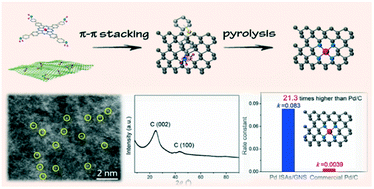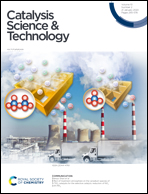In situ immobilization of isolated Pd single-atoms on graphene by employing amino-functionalized rigid molecules and their prominent catalytic performance†
Abstract
Downsizing the costly noble metals to the single-atomic level has attracted extensive attention due to the maximum atom efficiency, low coordination, and sufficient exposure of isolated active metal centers. Herein, with a focus on the functionalization of the palladium phthalocyanines with four aminophenoxy groups at the periphery of the benzene ring (PdPc-TAP), we successfully anchored the isolated Pd single atoms onto graphene (Pd ISAs/GNS) via the in situ immobilization and pyrolysis of PdPc-TAP. The omni bearing imprisonment of the Pd sites (XY-axis stabilized by the planar macrocyclic Pc and Z-axis anchored from the interactions between the claw-like tetra-amino groups and GO) is the key factor for the formation of Pd ISAs/GNS. The model hydrogenation reaction and density functional theory calculation revealed that the demonstrated catalytic activity of Pd ISAs/GNS was 21.3 times higher than that of the Pd/C, which is attributed to the near-zero adsorption of active H* species on Pd ISAs/GNS that can accelerate the preferential migration of dissociative H* species to the target molecule. This work not only highlights the synthesis and application of the noble metal-based single-atom catalyst, but also provides a versatile strategy for the construction of single-atom catalysts from the viewpoint of substituent-modified rigid molecules.



 Please wait while we load your content...
Please wait while we load your content...